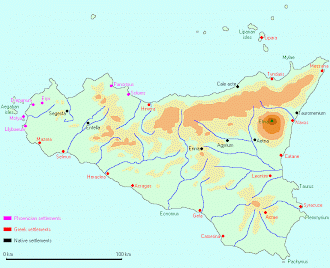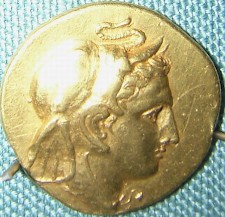Sicily (5)
Q1460Sicily: large and rich island opposite the Italian mainland. In Antiquity, it was settled by Phoenicians and Greeks, and contested by the Carthaginians, Romans, Ostrogoths, and Byzantines.
Late Fourth Century

The crisis of the year 354/344 was grave. There were revolutions in the cities of Sicily and southern Italy and effective government came to an end. Hicetas had liberated Syracuse from the tyranny of Dionysius II, who was isolated on the citadel in the island of Ortygia in the Syracusan harbor. The citizens had invited Corinth, which had founded Syracuse three centuries before, to offer help expelling the tyrant, and had asked the same from Carthage, which recognized a chance when it saw one. It sent ships to support Hicetas and in the year 344/343, its diplomats concluded alliances with Italian towns (the alliance with Rome is often but erroneously dated to the year 348, confusing Varronian and common chronology). It was clear for all to see that after almost permanent civil war since 357, Greek Sicily would be conquered by the Carthaginians.
Yet, things turned out differently, because Syracuse's mother-city Corinth did indeed send an army to help its colony, commanded by the efficient Timoleon. At the same time, king Archidamus III of Sparta came to the assistance of Tarentum. As we will see, their arrival marked the beginning of an age in which the Greeks, subdued by the Macedonian king Philip II, the father of Alexander the Great, started to show interest in the far west again.
Timoleon's expeditionary force was made up from mercenaries who had gained experience in the Third Sacred War (in which Philip of Macedonia had more or less conquered Central Greece). Evading a Carthaginian interception force, Timoleon arrived at Tauromenium, met the army of Hicetas, and unexpectedly attacked the man who had invited him. He now opened negotiations with Dionysius and offered collaboration in the war against Carthage. Dionysius agreed, allowed Timoleon's troops to enter Ortygia, beat off his enemies, and found himself outsmarted by Timoleon. In the summer of 343, Dionysius II accepted an offer to settle in Corinth and disappeared from the Sicilian scene.
Now, Timoleon could start with a project of recovery. Thousands of Greeks responded to his invitation to come to Sicily, accept grants of land, and repopulate the cities. (Their number is estimated at 60,000.) At the same time, Timoleon continued the war against Carthage and defeated his enemy at the river Cremisus, in the interior of the island.note (During this war, Carthage for the first time employed Greek mercenaries on a large scale.) A peace treaty was signed between Syracuse and Carthage in 339, and two years later, the other towns joined in, at about the same time as the cities of Greece proper and Philip of Macedonia signed the collective peace that is known as the Corinthian League. The border with the Carthaginian territories was to be the river Halycus again.
Timoleon celebrated his victory with an emission of coins showing Zeus Eleutherius, "Zeus the Liberator". At Syracuse, he reorganized the constitution, mixing elements of democracy, oligarchy, and monarchy. It was meant as a solid foundation for stability, peace, and prosperity, and indeed, Sicily saw a generation of peace.
Having accomplished his mission, Timoleon retired from public life as the second founder of the city, which restored its fortunes and wealth. Later generations were inspired, and already in 334 the king of Epirus, Alexander of Molossis (the brother-in-law of Alexander the Great) followed Timoleon's example and helped the Greeks of southern Italy ward off the native tribes.
So, Sicily prospered. Fear for Alexander the Great, who had plans to come to the west, may have inspired the Sicilians to refrain from internal fights. But after his death in 323, old tensions began to resurface. In Syracuse, the old inhabitants and the people who had been settled in Sicily by Timoleon could not stand each other. The conflict focused on the question whether Syracuse's mixed constitution should become more oligarchic or more democratic. In 316/315, a general named Agathocles defeated the oligarchs and became sole ruler (a remarkable twist in his democratic career).
The tyrant played the familiar old tune: he was supported by an army of mercenaries, tried to expand Syracuse's power by subduing the other Sicilian towns (this time Acragas, Gela, Messana), and when his popularity declined, provoked a war against Carthage. In 311, Agathocles was defeated near Himera, but when the Carthaginians laid siege to Syracuse. Although this city was strongly fortified, Agathocles had no effective army, and he decided upon a remarkable gamble: in August 310, he sailed away from Sicily, and invaded the Carthaginian homeland, Africa (modern Tunisia). Here, he won a brilliant victory, sacked Kerkouane, and he proceeded against Carthage itself.
At this stage, he concluded the treaty with Ophellas, a former officer of Alexander the Great who had fought in India and had made himself ruler of Cyrenaica. He was to bring new mercenaries to Agathocles, and in return would be made Agathocles' governor at Carthage. In the autumn of 308, his forces were added to those of Agathocles, who had him assassinated as soon as possible. The mercenaries had little choice and sided with Agathocles, who left them behind, returned to Sicily, and concluded a peace treaty with Carthage that left him in control of Sicily east of the Halycus (306). The mercenaries, left alone, were killed by the Carthaginians.

Agathocles, now ruler of a large part of Sicily and controlling formerly independent Greek cities, proclaimed himself king when he heard that in the east the Successors of Alexander (Antigonus, Demetrius, Ptolemy) had done the same. He was recognized when he married a stepdaughter of Ptolemy, and now tried to expand his kingdom to southern Italy. His daughter Lanassa married to king Pyrrhus of Epirus. Unfortunately, our main source, Diodorus of Sicily, does not describe these events. What is certain, however, is that he was unhappy with his family, did not want his sons to succeed him as king, and restored the Syracusan democracy on his death bed (288).
The reign of Agathocles, perhaps the most ruthless and most successful of all Syracusan tyrants, marks the last time that Sicily played an important and independent role in the history of the Mediterranean world. Inevitably, after his death, there was a period of anarchy. In the next century, the island was contested between Epirus, Rome, and Carthage.